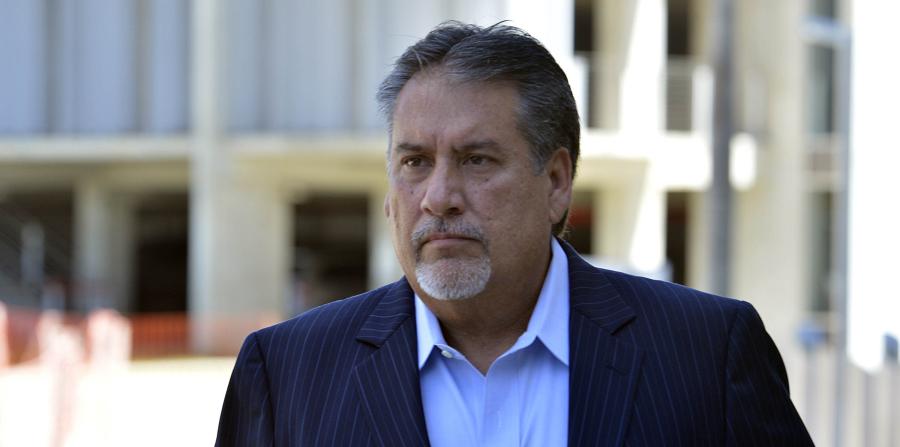Argument preview: Double jeopardy opens the Term

on Sep 22, 2016 at 3:22 pm
The new Supreme Court term presents an unusual opening focus on criminal cases: All five cases the first week of October, and all but one the next, have their nuclei in criminal prosecutions. First up is a complicated double jeopardy question arising out of a messy political corruption prosecution in Puerto Rico.
The petitioners in Bravo-Fernandez v. United States were federally prosecuted on various counts arising out of an alleged political bribery conspiracy. The jury acquitted Juan Bravo-Fernandez and his co-defendant Hector Martinez-Maldonato on some counts and convicted on others, but the convictions were vacated on appeal due to improper jury instructions. Bravo-Fernandez and Martinez-Maldonato now ask whether the jury’s acquittals on some counts block retrial on the remaining counts. They argue that the jury’s acquittal verdicts necessarily decided the central bribery allegation in the defendants’ favor for all counts.

Petitioner Juan Bravo-Fernandez (Photograph by José Rodríguez)
This brief description might spark a dim memory in lawyers of a certain age. In the old 1970 chestnut Ashe v. Swenson, taught with a smile to generations of law students, the Supreme Court ruled that a jury’s acquittal of Bob Fred Ashe for the robbery of one poker player precluded trial of Ashe for the robbery of the other players in the game, because the first trial dispositively settled the lone disputed issue (the identity of the robber) in Ashe’s favor. In Ashe, the court adopted the civil litigation doctrine of “collateral estoppel,” or in today’s terms, “issue preclusion,” to explain this constitutional double jeopardy preclusive effect. The question a week from Tuesday is whether Ashe’s collateral estoppel protection extends to cases in which the same jury also returned some convictions that were later vacated. Is retrial on the vacated conviction counts allowed? The court must also confront whether its 2009 decision in Yeager v. United States, which endorsed Ashe’s preclusive effects despite “hung” jury verdicts on other counts, can be distinguished.
A messy political corruption prosecution
Juan Bravo-Fernandez owned a private security firm in Puerto Rico; Hector Martinez-Maldonato was a senator for the commonwealth of Puerto Rico. Bravo-Fernandez wanted legislation that would benefit his business interests. In 2005 he allegedly bought expensive tickets to a boxing match in Las Vegas and paid for travel to, and meals and hotel rooms in, Las Vegas for Martinez-Maldonato and another senator, in return for the senators acting favorably on the legislation. Just before the five-year statute of limitations expired, federal prosecutors charged the two men with (among other things) federal program bribery, conspiracy to commit that bribery, and interstate travel in aid of the bribery.
After a three-week trial in 2011, the jury returned verdicts of not guilty on the conspiracy and travel counts. However, it returned convictions on the substantive bribery counts. The two men served some months in prison while their appeals were argued, but in 2012 the U.S. Court of Appeals for the 1st Circuit reversed their substantive bribery convictions because the jury instructions could have permitted the jury to convict under an improper “gratuity” theory instead of for bribery. (The court discussed this arcane but vital distinction in 1999 in United States v. Sun Diamond Growers.)
On remand, the district court initially entered a judgment of acquittal on all counts, but quickly vacated it when the government explained that the court of appeals had merely vacated the substantive convictions so that retrial was still possible. (A separate question of whether the withdrawal of the acquittal order was constitutional was denied review in the grant of certiorari here. An additional but perhaps irrelevant messiness is that other convictions of Bravo-Fernandez and Martinez-Maldonato were also reversed because the government had neglected to notice that the Puerto Rico laws on which they were based had been repealed before the conduct took place.) Bravo-Fernandez and Martinez-Maldonato then moved to bar any retrial on the substantive bribery counts, arguing that “a rational jury could not have acquitted [them] of conspiring and traveling to violate” the bribery statute “without necessarily deciding that they did not” commit substantive bribery at all. The parties now agree that the jury’s verdicts here were “inconsistent”; the defendants argued below that Ashe v. Swenson’s collateral estoppel principles preclude retrial.
The district court, however, denied the defendants’ double jeopardy motion, and the 1st Circuit affirmed. (An immediate pretrial appeal was allowed because the double jeopardy clause represents a “right not to be tried at all” that would be lost if appeal were delayed until after trial.) The 1st Circuit ruled that because the jury’s convictions for substantive bribery were “inconsistent” with their acquittals on the conspiracy and travel to commit bribery counts, it was not possible to determine what the jury had “necessarily decided” about bribery. Thus, the appeals court said, the vacated convictions “strip the acquittals … of collateral estoppel effect.”
Significantly, the 1st Circuit ruled that this case was distinguishable from Yeager v. United States, in which the Supreme Court ruled that when a jury acquits on some counts but is “hung” (that is, cannot reach a unanimous decision) on other counts, Ashe’s preclusive collateral estoppel doctrine prohibits retrial on the hung counts. Yeager held that “consideration of [arguably inconsistent] hung counts has no place” in the analysis. But the 1st Circuit ruled here that vacated convictions are different from hung counts – and in fact at least two other federal courts of appeals have so ruled. Thus the question of how Ashe and Yeager apply when vacated convictions are present alongside acquittals is now before the court.
Interesting side-notes
Before discussing the merits, here are a few “inside baseball” points that will interest only the most eager Supreme Court fans:
— Yeager was written by Justice John Paul Stevens a year before he retired in 2010. The 1st Circuit’s decision here, which found Yeager distinguishable, was written by Judge David Barron, a 1996 clerk for Stevens.
— Meanwhile, Elizabeth Prelogar, who will argue for the United States here, clerked for Stevens’s replacement Elena Kagan – and prior to that, for Justice Ruth Bader Ginsburg. Lisa Blatt, a former Assistant to the Solicitor General who will argue for Bravo-Fernandez, also clerked for Ginsburg some twenty years earlier, when the justice was a judge on the U.S. Court of Appeals for the District of Columbia Circuit. A week from Tuesday, Ginsburg will surely will be listening with pride as well as interest.
— Finally, Deputy Solicitor General Michael Dreeben, who argued Yeager, is arguing a very important insider trading securities case (Salman v. United States) the next day, so he won’t be arguing here.
Arguments of the parties
This is truly a case in which both sides muster strong, if diametrically opposed, arguments. Here is an oversimplified summary of the roughly 120 pages of briefing (not counting amicus briefing – which perhaps notably has all been on the side of the defendants here).
Bravo-Fernandez and Martinez-Maldonato argue that counts that have been vacated because the jury instructions made the convictions improper cannot justly be relied upon to say anything about the jury’s rational decisions. Ashe permits consideration only of “final and valid” judgments, and just like the hung counts in Yeager, legally erroneous convictions leading to no judgment at all should be treated as “nonevents.” “Yeager controls this case,” they say.
They also maintain that Ashe recognized the modern-day dangers created by the “extraordinary proliferation of overlapping and related statutory offenses” (which, if a problem, has surely grown worse in the intervening 45 years). “Prosecutorial abuses” involving overcharging should not be encouraged, and will be stemmed by not allowing prosecutors to charge multiple counts for the same conduct in the hope that at least some convictions, even if invalid, will avoid a double jeopardy bar. The constitutional danger, recognized in Yeager as well as Ashe, of allowing the state “repeated attempts” at conviction, should be avoided by reversing the 1st Circuit here.
The government responds, however, that certainty regarding what a jury “necessarily decided” cannot be present where a jury has also convicted on related counts. The court has long recognized (in United States v. Powell in 1984 and Dunn v. United States in 1932) that logically inconsistent verdicts are not unconstitutional: When a jury acquits on some counts while convicting on others, even if such an outcome seems inconsistent and irrational, the convictions stand. The same should be true, the government argues, when jury convictions are later vacated on appeal. Given that the jury here convicted the defendants of substantive bribery, it simply cannot be determined that the jury “necessarily decided” that they were innocent of bribery by acquitting them on related (not identical) counts. In light of the inconsistency, the most that can be said is that the jury’s findings are unclear, and Ashe’s question about what the jury “necessarily decided” is “unanswerable” in such a case. The government argues that the burden of proving what the jury “necessarily decided” under Ashe rests on the defendants, and the uncertainty created by inconsistent verdicts renders that burden impossible to carry.
Meanwhile, the government maintains, under settled double jeopardy doctrine, retrial after convictions that are vacated is usually permissible, because the government is entitled to one full and fair opportunity to pursue charged counts to conviction. This is true even when convictions are reversed due to erroneous jury instructions. Under this doctrine, the defendants here should be retried on the bribery charges for which the jury initially convicted them, with the erroneous jury instructions corrected at the new trial.
Finally, the government rejects the defendants’ “prosecutorial abuse” worries as speculative “policy arguments,” and notes that there are also “significant interests” favoring final resolution of conviction counts that have been vacated, which also “deserve respect.”
Conclusion
With regard to the dynamics of the court in this case, it may prove important that since she joined the court in 2009, Justice Sonia Sotomayor seems to have made the double jeopardy clause one of her special interests, beginning with her vigorous 2012 dissent in Blueford v. Arkansas and continuing with her joining in Justice Stephen Breyer’s dissent last term in Puerto Rico v. Sanchez Valle. The force of her voice on criminal justice issues is considerable, while at the same time, Justice Antonin Scalia’s strong voice questioning the entire theory of Ashe will be absent. As the short-handed court continues to work hard to avoid 4-4 ties, Justice Anthony Kennedy may be, once again, “the decider” here. Listen carefully for his views.
More generally, the tortured procedural path of this case hardly reaches the sympathetic level of Ashe’s simple poker-game facts; and some justices have never accepted Ashe’s entire extra-textual theory of collateral estoppel. Meanwhile, the three courts of appeals that have evaluated the effect of Yeager have distinguished it in the “vacated convictions” context.
Still, the justices have in recent years all expressed concerns about the proliferation of overlapping federal crimes and the dangers of over-charging – remember Yates v. United States, the “fish as tangible object” case from 2015. Jury acquittals after a lengthy trial must carry some weight or benefit; the question is, how much? While the excellent briefing leaves me currently in equipoise (although I did find the defendants’ rhetorical references in their reply brief to Lance Armstrong and Prohibition a bit much), oral argument may prove that the case is more one-sided than it looks. Tune in the first Wednesday in October after listening to the court’s concerns.
[Disclosure: Vinson & Elkins LLP, whose attorneys contribute to this blog in various capacities, is among the counsel on an amicus brief in support of the petitioners in this case. The author of this post, however, is not affiliated with the firm.]


